A History of Football Kit Design in England and Scotland
(1) A Game for Gentlemen 1857-1879
The game of football is generally considered to have originated in the mob games played in the Middle Ages between rival villages without rules and with unlimited players on each side. The Royal Shrovetide football match is a supposed survival of this early form of the game. Modern scholarship has, however, revealed that small-side games, played by young men according to locally agreed rules, were commonplace. As these were the pastimes of the common people rather than the ruling classes, they went largely unrecorded.
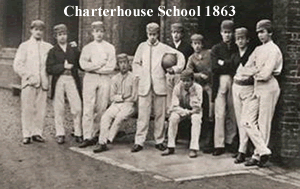 The first recognised rules of football were laid down by English public schools to govern inter-house competition and fell broadly into two groups; the handling game developed at Rugby School and the dribbling game that emerged from Eton, Harrow, Winchester, Uppingham, Shrewsbury, Marlborough and Charterhouse, each of which had their own versions. In keeping with the philosophies of the public schools of the time, these games could be extraordinarily violent, with hacking (kicking an opponent's shins) encouraged.
The first recognised rules of football were laid down by English public schools to govern inter-house competition and fell broadly into two groups; the handling game developed at Rugby School and the dribbling game that emerged from Eton, Harrow, Winchester, Uppingham, Shrewsbury, Marlborough and Charterhouse, each of which had their own versions. In keeping with the philosophies of the public schools of the time, these games could be extraordinarily violent, with hacking (kicking an opponent's shins) encouraged.
When the young gentlemen from these schools went up to university they formed football clubs but with no consensus on the rules, these had to be agreed before every game. The first attempt to draw up a uniform set of rules took place at Cambridge University in 1848. Although the originals are lost, a set of Cambridge Rules from 1856 survives in the library of Shrewsbury 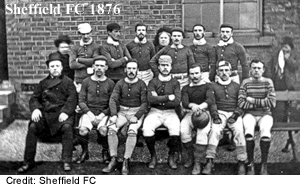 School.
School.
The first football clubs also emerged around this time, most notably Sheffield FC (1857 - the world's oldest club), Hallam (1860) and Notts County (1862). The Sheffield Rules, published in 1859, were widely adopted by the newly emerging clubs in the north and midlands. The majority of games took place within a club, school or university and it took some time for the notion of inter-club matches to catch on. When they did teams might consist of 9 to 18 players and it was common for different codes to be used in the first and second halves.
There were no uniform kits: players would turn out in whatever they had to 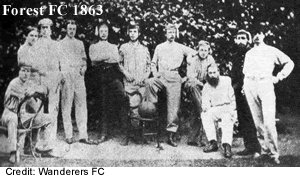 hand and teams would be distinguished by wearing distinctively coloured caps,
scarves or sashes over cricket whites (many clubs were formed by cricketers seeking a team game for the winter) or whatever else players had to hand. The first reference to "colours" comes from the rules of Sheffield FC in 1857, which stated:
hand and teams would be distinguished by wearing distinctively coloured caps,
scarves or sashes over cricket whites (many clubs were formed by cricketers seeking a team game for the winter) or whatever else players had to hand. The first reference to "colours" comes from the rules of Sheffield FC in 1857, which stated:
"Each player must provide himself with a red and dark blue flannel cap, one colour to be worn by each side."
On 2nd January 1865 the Sheffield FC team travelled by train to Nottingham to play Nottinghamshire FC (who would become Notts County), winning 1-0. This was the first ever inter-city match and an early indication of how the growth of the railways would be instrumental in the development of association football.
In 1863 leading players formed the Football Association and drew up the first set of national laws of the game, drawing upon the Cambridge Rules and those of the Sheffield
Club. These became known as the Association Rules. Spectators were generally regarded as a nuisance and the
game was a robust pursuit for gentlemen from the upper classes. The leading clubs of the day were formed by old boys from the major public schools (Old Etonians,
Old Carthusians etc), by 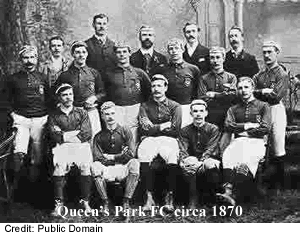 officers serving in the Army (Royal Engineers) and
at Oxford and Cambridge Universities.
officers serving in the Army (Royal Engineers) and
at Oxford and Cambridge Universities.
Scotland's oldest club, Queen's Park, did much to popularise the game north of the border through exhibition games and a tour of Ireland led to the formation of the Irish FA. They played under their own code until 1870 when they joined the Football Association. Several of their own rules were subsequently incorporated into the Associaton Rules. Like their English counterparts, Queen's Park initially required members to provide caps, cowls, scarves or badges in distinctive colours to distinguish between the sides. In 1870, however, their rules required players to provide themselves with a navy guernsey and cowl. Rules governing hose were introduced in following seasons.
When England met Scotland in 1872 for the world's first ever international fixture, the Scottish team, all of whom played for Queen's Park, wore their navy blue club guernseys. Despite some dalliances with other colours in the early days, Scotland's national team wear navy to this day.
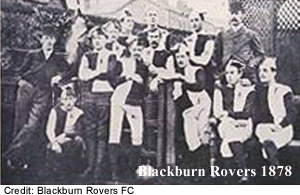 The introduction of the English FA Cup in 1871-72 marked a turning point as it required all participating teams to play by the FA Rules. Furthermore, it encouraged an increase in the number of fixtures played against "foreign" teams, highlighting the importance of clubs adopting distinctive colours.
The introduction of the English FA Cup in 1871-72 marked a turning point as it required all participating teams to play by the FA Rules. Furthermore, it encouraged an increase in the number of fixtures played against "foreign" teams, highlighting the importance of clubs adopting distinctive colours.
In England colours were often those of the public schools with which the game was associated: Blackburn Rovers wore dark-blue and white colours and Maltese Cross of Shrewsbury School, where several of their founders were educated, for example. The Royal Engineers, who won the first FA Cup final, wore their dark red 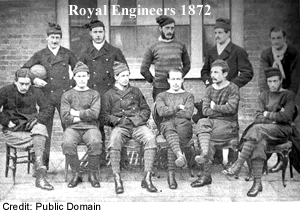 and dark blue regimental colours while their opponents, the Wanderers were in orange, cerise and black. The Old Etonians wore their traditional Eton Blue while Clapham Rovers were in Cerise and French Grey. (The Eminent Victorians section on HFK illustrates the extraordinary variety of colour combinations worn during this early period.)
and dark blue regimental colours while their opponents, the Wanderers were in orange, cerise and black. The Old Etonians wore their traditional Eton Blue while Clapham Rovers were in Cerise and French Grey. (The Eminent Victorians section on HFK illustrates the extraordinary variety of colour combinations worn during this early period.)
Caps, cowls and other headgear were de rigeur throughout the decade and served to help distinguish teams wearing similar colours. Some teams allowed their players to wear different headgear so that spectators could pick out their favourites and when Wales met Scotland in their first ever international fixture in 1876, the match programme gave details of each player's socks. Headgear gradually fell out of favour towards the end of the decade, probably because it interfered with players using their heads to play the ball (one of several innovations pioneered by Queen's Park). The tradition survives in the practice of awarding caps to players chosen to represent their national or county FA.
The game was played
almost exclusively by gentlemen of means who could afford to buy jerseys in their
club colours from their tailor or gentlemen's outfitter. Registration rules were very loose and some of the leading players, who were not troubled by having to earn a living, would play several times a week for different 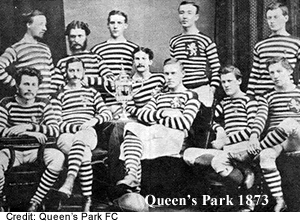 teams.
teams.
Tops came in two styles. Jerseys (or guernseys) were made from woven wool, were hard wearing and remained warm when wet. They could be plain, self coloured, horizontally striped (vertical stripes were not available at the time) and usually had a crew neck. The stripes came in various widths but the most popular seems to have the narrow, 1" version adopted by Queen's Park in October 1873.
Shirts were made from cotton or finely carded wool and would have a collar with a buttoned fly. These were produced in a range of colours with contrasting or self coloured collars. Confusingly for the modern reader, the Victorian term "quartered" describes shirts that were half-and-half (ie with the torso made in four sections. The 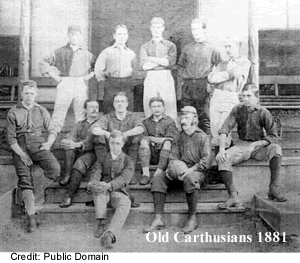 term for the design we would describe as quartered was "harlequin."
term for the design we would describe as quartered was "harlequin."
Both jersey and shirts were available in a wide range of often exotic colour combinations but that said, plain white shirts were very popular, being both relatively cheap and easily obtainable.
Knickerbockers (which had to cover the knee to prevent any female spectators from being scandalised) were available in white or dark blue. Some teams specified the colour players were expected to wear but most did not and photographs of the period show players in all sorts of outfits including full-length trousers and cricket ducks.
Sam Weller Widdowson is credited with introducing shin guards to the sport in 1874. He played cricket for Nottinghamshire during the summer and football for Nottingham Forest in the winter. He took a pair of cricket pads, cut them down and strapped them to the outside of his stockings. After some initial ridicule, players quickly saw the wisdom of protecting themselves. As professionalism crept into the game, players who relied on the game for their livelihood wore them as a matter of course.
The FA and SFA applied the strictest amateur principles including a requirement that players provide their own kit. This, along with the rules that banned clubs from paying for expenses or making broken-time payments were substantial barriers to the participation of working people until 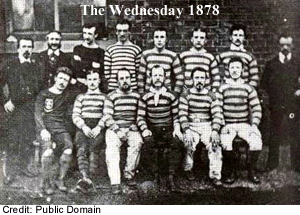 well into the following decade. This was not an accident as the gentlemen who played and ran the game in England were determined to exclude the inferior social classes from their exclusive pastime.
well into the following decade. This was not an accident as the gentlemen who played and ran the game in England were determined to exclude the inferior social classes from their exclusive pastime.
Very often club colours were described in the simplest of terms and it is evident that players might wear whatever they had in the wardrobe as long as they were in the colours of their team as can be seen in these photographs of The Wednesday and the Welsh team, Newtown White Star. A corespondent for the Maidenhead Advertiser wrote on 6 November 1872 in praise of the smart appearance of the Southall club,
"This uniform was much admired, and a capital contrast to our red and black team who, by the bye, are never all alike in dress, which is a great pity."
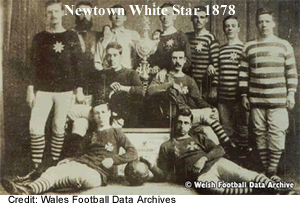 Simple crests were sometimes worn to create a degree of individuality for clubs. These were typically abstract designs including stars of various kinds, Maltese crosses, saltires or monograms. Some of the most popular motifs bear a passing resemblance to Masonic symbols but there is absolutely no evidence to suggest that this was due to the influence of Stonemasons. Rather they were simple designs that could be readily cut from cloth and sewn onto the players' tops.
Simple crests were sometimes worn to create a degree of individuality for clubs. These were typically abstract designs including stars of various kinds, Maltese crosses, saltires or monograms. Some of the most popular motifs bear a passing resemblance to Masonic symbols but there is absolutely no evidence to suggest that this was due to the influence of Stonemasons. Rather they were simple designs that could be readily cut from cloth and sewn onto the players' tops.
Hackney Black Rovers wore a piratical skull and crossbones on their black jerseys in 1875 but alas no photographs have survived.
Aston Villa, a club with strong Scottish connections, went so far as to incorporate the Scots lion rampant into their jerseys. William McGregor, who helped found the club, traveled to Scotland in 1878 to buy a set of 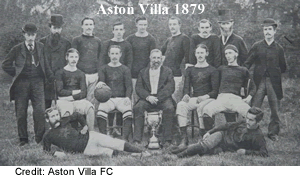 red lions which were then sewn onto the team's black jerseys by the sister of the club secretary. Charles S Johnstone, a prominent player, would later recall,
red lions which were then sewn onto the team's black jerseys by the sister of the club secretary. Charles S Johnstone, a prominent player, would later recall,
"Our lion had no chance with the washing lady! He became pale and anaemic so Mac (McGregor) was deputed to send to Scotland for thirteen lions on shields proper, which could be attached and detached at will....When they were duly attached you could hardly see the man for the lion." (The Aston Villa Chronicles, John Lerwill 2009.)
After the 1872 Scotland v England international, several players from both teams removed the national emblems from their tops and attached them to their club jerseys as a matter of pride. Players chosen to 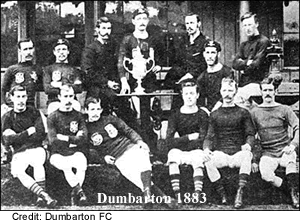 represent their county FA's began to follow suit and soon team photographs were adorned with players sporting a variety of badges and caps.
represent their county FA's began to follow suit and soon team photographs were adorned with players sporting a variety of badges and caps.
If the English game
continued to be dominated by former public school clubs until the early 1880s, in Scotland, association football took a diiferent course. The Queen's Park club, while drawing its membership from the prosperous middle and upper classes of Glasgow and standing firmly behind their founding amateur principles (as they did until 2020 when the members agreed to adopt professionalism), shared none of the snobbish attitudes of their Engish counterparts. They set about a vigorous campaign of exhibition matches to popularise the game throughout central Scotland and further afield. These found a ready audience among the commanding officers of the many part-time Volunteer Regiments who saw the potential to build team spirit and physical fitness among their members while 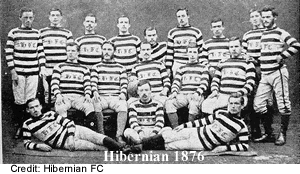 Presbyterian ministers saw the opportunity to offer an alternative to the public house to their male parishioners.
Presbyterian ministers saw the opportunity to offer an alternative to the public house to their male parishioners.
The formation of Hibernian FC in 1875 by impoverished Irish emigres living
in Edinburgh marked another departure from the game's English upper class
origins. With the active support of the Catholic church, similar clubs sprang
up all over Scotland, all wearing green to celebrate their Irish roots.
The sectarianism that was a feature of Scottish life quickly became apparent:
blue (usually navy), white and red are the colours of Unionism (and were the original colours of Hearts, for example) and became associated
with the Presbyterian establishment while green and white were universally adopted
by the clubs with roots in the poor Catholic minority. These sectarian affiliations
faded 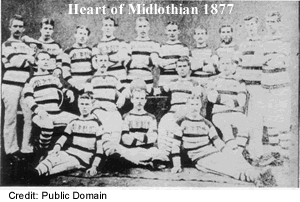 away over time with the notable exception of the intense rivalry between Rangers and Celtic.
away over time with the notable exception of the intense rivalry between Rangers and Celtic.
Although uniform kits were becoming the norm some teams continued to turn out in a mixture of different tops and knickers. A reporter commenting on the appearance of Birmingham Association in the FA Cup in 1879 wrote:
"In football it is a most essential point that the members of one team should be clearly distinguished from those of the other. The only way this can be effected is for each club to have a distinct uniform as the diversity of dress displayed yesterday not only confused the members of the team but the spectators were quite unable to say whether a man belonged to one team or the other."
When Darwen, a team of cotton mill workers met the Old Etonians in the FA Cup semi-final of 1879, two worlds collided. Darwen were derided for wearing trousers cut off at the knee (held up by braces) instead of knickerbockers and a motley collection of shirts. The Darreners took the gentlemen-players from Eton to two replays before they were beaten, exhausted by working full shifts at the cotton-mills and repeated train journeys to London. Nevertheless this match is regarded as the turning point between the old establishment of gentleman-players and the new breed of working-class clubs emerging in Lancashire and the Midlands.
© Dave Moor (2023)